Plant Abuse Chart and Photos
Heat Stress:
Look closely below, and you’ll see the brown leaf edges that are indicative of heat stress. This damage looks a lot like nutrient burn, except it occurs only at the tops of the plants closest to the lamps. There’s only one cure for this…get the heat away from the plants, either by moving the lamps or moving the plants.
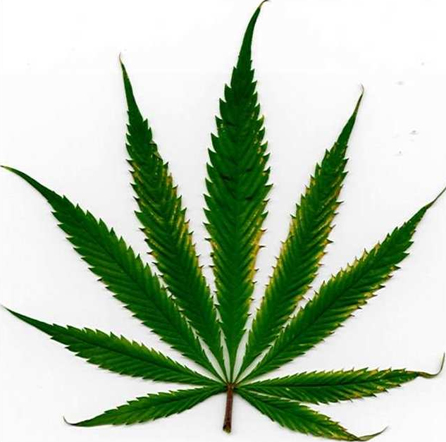
Nutrient Solution Burn:
There’s a good chance that this leaf was subjected to nutrient solution burn. These symptoms are seen when the EC concentration of hydroponic solutions is too high. These symptoms also appear when strong nutrient solution is splashed onto the leaves under hot HID lamps, causing the leaves to burn under the solution.
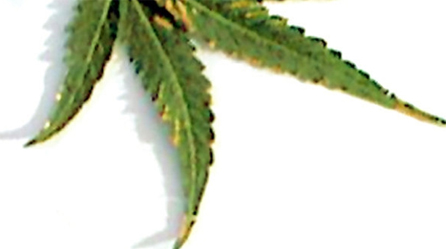
Many hydroponic gardeners see this problem. It’s the beginning of nutrient burn. It indicates that the plants have all the nutrients they can possibly use, and there’s a slight excess. Back off the concentration of the nutrient solution just a touch, and the problem should disappear. Note that if the plants never get any worse than this leaf (figure 3), then the plants are probably just fine. Figure 4 is definitely an over-fert problem. The high level of nutrients accumulates in the leaves and causes them to dry out and burn up as shown here. You must flush with clear, clean water immediately to allow the roots to recover, and prevent further damage. Now find the cause of the high nutrient levels.
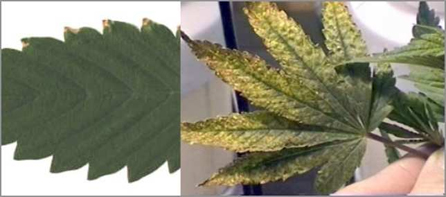
Over Watering:
The plants in figure 5 were on a continuous drip system, where nutrient solution is constantly being pumped into the medium. This tends to keep the entire root system completely saturated. A better way would be to periodically feed the plants, say for 1/2 hour every 2-3 hours. This would give the roots a chance to get needed air to them, and prevent root rot and other problems. Don’t be throw off by the fact that the plants in figure 5 are sitting in still water, this is actually an H2O2 solution used to try and correct the problem. Adding an air stone to the tub would also help add O2 to the solution.
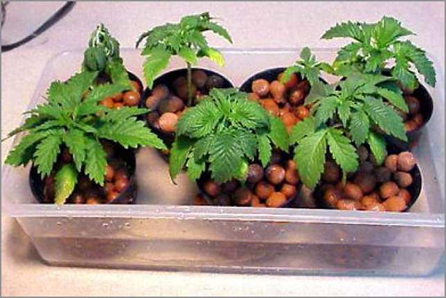
pH Fluctuation:
Both of these leaves in figure 6 and figure 7 are from the same plant. It could be over fertilization, but more likely it is due to the pH being off. Too high or too low a pH can lock up nutrients in the form of undisolvable salts and compounds, some of which are actually toxic to the plants. What then happens is the grower then tries to supplement the plants diet by adding more fertilizers, throwing off the pH even more and locking up even more nutrients. This type of problem is seen more often in soil mixes, where inconsistent mixing of the medium’s components leads to “hot” spots.
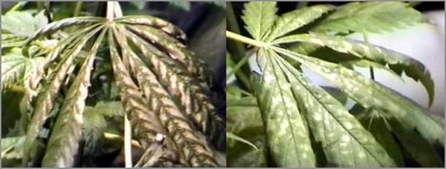
Ozone Damage:
Ozone damage typically found near the generator. Although a rare problem, symptoms generally appear as a Mg deficiency, but the symptoms are localized to immediately around the generator.
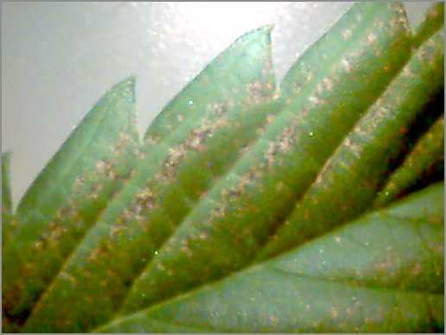
NUTRIENT PROBLEMS
Root Stunting
Root stunting is characteristic of calcium deficiency, acidity, aluminum toxicity, and copper toxicity. Some species may also show it when boron deficient. The shortened roots become thickened, the laterals become stubby, peg-like, and the whole system often discolours, brown or grey.
Symptoms localized at shoot growing points. New shoots unopened; young leaves distorted; dead leaf tips; pale green plant copper deficiency New shoots withered or dead; petiole or stem collapse; shoots stunted; green plant calcium deficiency Young leaves pale green or yellow; rosetting or dead tip; dieback; dark green plant boron deficiency.
MOBILE ELEMENTS
Mobile elements are more likely to exhibit visual deficiencies in the older leaves, because during demand these elements will be exported to the new growth.
Nitrogen (N)
Nitrate – Ammonium is found in both inorganic and organic forms in the plant, and combines with carbon, hydrogen, oxygen and sometimes sulfur to form amino acids, amino enzymes, nucleic acids, chlorophyll, alkaloids, and purine bases. Nitrogen rates high as molecular weight proteins in plant tissue. Plants need lots of N during vegging, but it’s easy to overdo it. Added too much? Flush the soil with plain water. Soluble nitrogen (especially nitrate) is the form that’s the most quickly available to the roots, while insoluble N (like urea) first needs to be broken down by microbes in the soil before the roots can absorb it. Avoid excessive ammonium nitrogen, which can interfere with other nutrients. Too much N delays flowering. Plants should be allowed to become N-deficient late in flowering for best flavor.
Nitrogen Deficiencies:
Plants will exhibit lack of vigor, slow growth and will be weak and stunted. Quality and yield will be significantly reduced. Older leaves become yellow (chlorotic) from lack of chlorophyll. Deficient plants will exhibit uniform light green to yellow on older leaves, these leaves may die and drop. Leaf margins will not curled up noticeably. Chlorosis will eventually spread throughout the plant. Stems, petioles and lower leaf surfaces may turn purple.
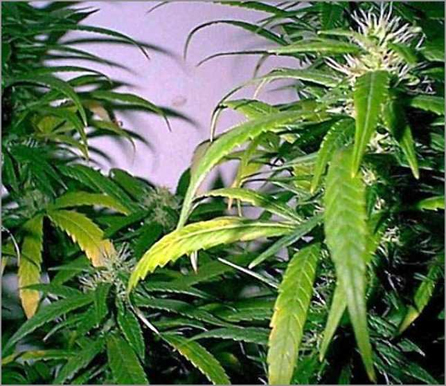
Nitrogen Toxicity:
Leaves are often dark green and in the early stages abundant with foliage. If excess is severe, leaves will dry and begin to fall off. Root system will remain under developed or deteriorate after time. Fruit and flower set will be inhibited or deformed. With breakdown of vascular tissue restricting water uptake. Stress resistance is drastically diminished.
Phosphorus (P)
Phosphorus is a component of certain enzymes and proteins, adenosine triphosphate (ATP), ribonucleic acids (RNA), deoxyribonucleic acids (DNA) and phytin. ATP is involved in various energy transfer reactions, and RNA and DNA are components of genetic information.
Phosphorus (P) deficiency:
Figure 11 is severe phosphorus (P) deficiency during flowering. Fan leaves are dark green or red/purple, and may turn yellow. Leaves may curl under, go brown and die. Small-formed buds are another main symptom. Phosphorus deficiencies exhibit slow growing, weak and stunted plants with dark green or purple pigmentation in older leaves and stems. Some deficiency during flowering is normal, but too much shouldn’t be tolerated. Red petioles and stems are a normal, genetic characteristic for many varieties, plus it can also be a co-symptom of N, K, and Mg-deficiencies, so red stems are not a foolproof sign of P-deficiency. Too much P can lead to iron deficiency. Purpling: accumulation of anthocyanin pigments; causes an overall dark green color with a purple, red, or blue tint, and is the common sign of phosphate deficiency. Some plant species and varieties respond to phosphate deficiency by yellowing instead of purpling. Purpling is natural to some healthy ornamentals.
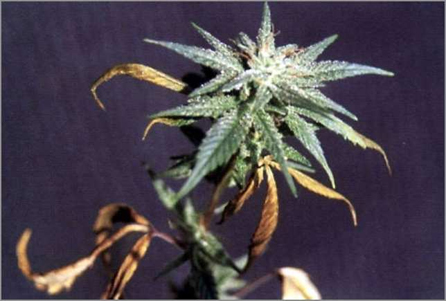
Figure 12 shows Phosphorus (P) deficiency during vegetative growth. Many people mistaken this for a fungus, but look for the damage to occur near the end of leave, and leaves the color dull greyish with a very brittle texture.
Phosphorus (P) Toxicity:
This condition is rare and usually buffered by pH limitations. Excess phosphorus can interfere with the availability and stability of copper and zinc.
Potassium (K)
Potassium is involved in maintaining the water status of the plant and the tugor pressure of it’s cells and the opening and closing of the stomata. Potassium is required in the accumulation and translocation of carbohydrates. Lack of potassium will reduce yield and quality.
Potassium deficiency:
Older leaves are initially chlorotic but soon develop dark necrotic lesions (dead tissue). First apparent on the tips and margins of the leaves. Stem and branches may become weak and easily broken, the plant may also stretch. The plant will become susceptible to disease and toxicity. In addition to appearing to look like iron deficiency, the tips of the leaves curl and the edges burn and die.
Potassium – Too much sodium (Na) displaces K, causing a K deficiency. Sources of high salinity are: baking soda (sodium bicarbonate “pH-up”), too much manure, and the use of water-softening filters (which should not be used). If the problem is Na, flush the soil. K can get locked up from too much Ca or ammonium nitrogen, and possibly cold weather.
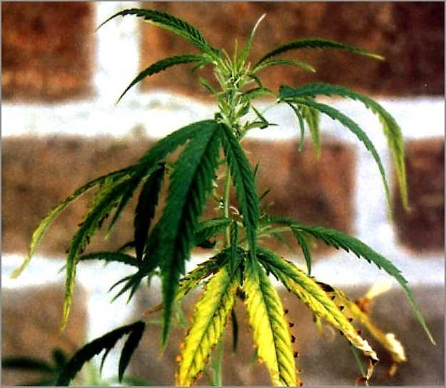
Potassium (K) Toxicity:
Usually not absorbed excessively by plants. Excess potassium can aggravate the uptake of magnesium, manganese, zinc and iron and effect the availability of calcium.
Magnesium (Mg)
Magnesium is a component of the chlorophyll molecule and serves as a cofactor in most enzymes.
Magnesium (Mg) deficiency:
Magnesium deficiency will exhibit a yellowing (which may turn brown) and interveinal chlorosis beginning in the older leaves. The older leaves will be the first to develop interveinal chlorosis. Starting at leaf margin or tip and progressing inward between the veins. Notice how the veins remain somewhat green though as can be seen in figure 15. Notice how in figure 16 and 17 the leaves curl upwards like they’re praying? They’re praying for Mg! The tips may also twist. This can be quickly resolved by watering with 1 tablespoon Epsom salts/gallon of water. Until you can correct nutrient lockout, try foliar feeding. That way the plants get all the nitrogen and Mg they need.

